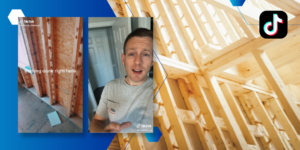
With the construction supply chain on a constant rollercoaster, many builders have taken to looking towards alternative materials, and thanks to TikTok, one has been getting more and more attention: the Tstud™.
The Tstud™ has been drawing in a significant amount of interest from builders over the last few years since its development, due to its purported ability to increase a home’s energy efficiency — and recently, it brought in a bit of publicity on social media.
After user @messina_snipegod posted a video questioning the quality of framing done on a house with unidentified “pegs” — asking “what is this?” — user @inspector_aj stepped in to explain that the build was actually of high quality, saying that the “pegs” were in fact Tstuds™, which had “huge energy-saving properties.”
“…[The T-Stud™] actually diminishes thermal transfer from the inside to the outside of your home,” he said, “saving you a ton of money as a home owner.”
“Inspector AJ” is Austin Jenkins, a Certified Professional Inspector from Tennessee with a huge social media imprint that includes 1.7 million TikTok followers.
Related coverage: 17 Alternatives to Common Building Materials
What is the Tstud™?
Inspector AJ’s take on the Tstud™ is in line with what inventor Brian Iverson intended for the product, as well as what other home builders have said about it.
The Tstud™ company claims that it serves as a six-in-one solution to thermal bridging in wall framing that is also more cost-effective and eco-friendly than other options — and many in the industry are agreeing.
A video posted by the official Tstud TikTok (also stitching user @messina_snipegod) account noted “When used with spray insulation, the Tstud™ prevents heat gain in the summer, heat loss in the winter, and adds an extra sound protection to the home.”
Tik Tok user @birnamdesignco also noted the potential energy efficiency of the product as well, saying in their own TikTok that “if you have a full stud…[heat] will transfer much faster” and that the Tstud™ allows for “a thermally broken wall at all points, except for those little points where you have the dowels.”
SALA Architects’ Marc Sloot noted how important it is to have materials that help builders create more energy-conservant structures.
“There are lots of ways to do it but you get into the weeds on the complexities of how to install and fasten the units, whereas the Tstud™ can go right up to the edge of the rough opening,” Sloot said.
He also pointed out the importance of having alternative materials that still use familiar methods, saying that the Tstud™ “simplifies the process [of insulation] and uses conventional methods that framers are used to.”
How much does Tstud™ cost?
Building with Tstud™ can have variable costs: “On average, we are about $2-$3/LF depending on size of order, logistics, and grade of product,” said Abi Wurschmidt, Chief Marketing Officer at Tstud™.
“Although we are a sustainable replacement for 2×6 and 2×8 standard lumber, we don’t like to compare pricing to standard lumber,” Wurschmidt noted. “Standard lumber doesn’t provide a 96% thermal break through the wall assembly and thus the pricing is going to be quite different. We’re less than putting foam on the exterior of the home and we’d consider ourselves in the category of thermal break products instead.”
Builder Brad Stokes said that the upfront cost of Tstud™ is worth the future costs of energy conservation without making a structure’s walls thicker — an important development when “Everyone seems to be advocating for thicker and thicker walls these days, as if space as free.”
“At $1,000 or even $5,000 more, it’s an intriguing option to consider — especially since it’s probably much stronger than my only other option of building a 2×4 wall with foam,” Stokes continued. “Whether it’s this product or something similar, I am a potential customer.”
Tstud™ provides testing and reports — including U-Factor value calculations for a variety of wall assemblies built using Tstuds — on its testing and reports page.
The ongoing supply chain crisis has shown how important it is for contractors to find alternate sources for their building materials — or completely alternate materials themselves.
A recent survey from the Associated General Contractors of America (AGC) noted 61% of respondents stated their need for alternative suppliers, with 48% specifically looking towards alternative materials as a solution for their materials shortages. The supply chain crisis is affecting all areas of the industry, even going so far as to cause a shortage in construction-suitable sand worldwide.
In fact, in reaction, the market for alternative building materials is expected to grow significantly in the next few years. Straits Research reported that after the alternative building market in North America was valued at $205 billion in 2021, the sector would be projected to reach a value of $345 billion by 2030.
Check up-to-date material prices with the Construction Materials Price Tracker.